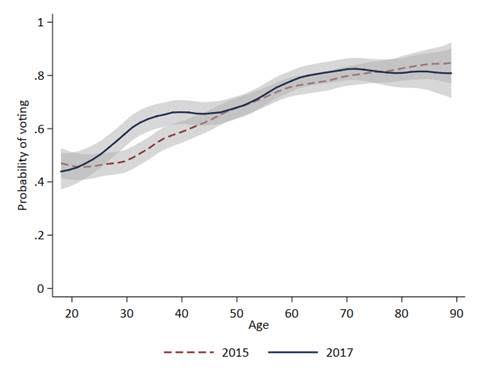The myth of youth turnout at the 2017 general election
Out today is the latest data from the British Election Survey (BES), focusing on turnout. It was up at the 2017 general election, making it the fourth general election in a row at which turnout has risen (and the full picture is even better than that).
But it wasn’t young people who fuelled the turnout rise.
Youth turnout was not changed much on last time – most likely up a bit, but possibly even down when you bear in mind the margins of error (the grey zones on the graph below). Instead the rise in turnout came from those in their late 20s and 30s.

This conclusion contradicts a lot of post-election punditry and the Oxford English Dictionary’s rush to embrace the new word youthquake as its word of the year. Ironically Collins Dictionary was more on the button with its choice of fake news as its word of the year. (No, don’t ask me how two words make it as the word of the year.)
Why did pundits get this wrong? Turnout did go up in constituencies with lots of young voters. But it wasn’t the young pushing turnout up in those seats. Rather it was older people living in places with lots of youth voters whose turnout went up. (This was a version of the ecological fallacy.)
How do we know that the BES is right? For two reasons, which are part of why it is treated as the gold standard of election research.
First, they do extensive door-to-door surveying. Not internet, not phones but good old doorstepping, including – crucially – going back repeatedly to the same doors when people don’t first respond. This means their sampling suffers much less from the problem of being biased in favour of people who are keener to do polls and easier to get hold of. (Caveat – although door-step surveying of this sort is very powerful, it’s not infallible. There was a doorstep poll done for a hedge fund in 2017 that got the result wrong.)
Second, BES ties up its doorstep surveys with checking the actual marked registers from the election. They don’t just ask if you voted, they actually check if you really did. (This data is in turn used by other pollsters to create their models of how truthfully you should take answers to questions about whether you will/did vote.)
Footnote: it wasn’t either that youth registration surged, which would have been a different form of youthquake not caught by turnout figures (which are based in the UK on the electoral register not on the potential voting population).
2017 turnout: BES research paper
Tremors but no Youthquake – Measuring changes in the age and turnout gradients at the 2015 and 2017 British General Elections by Christopher Prosser, Edward Fieldhouse, Jane Green, Jonathan Mellon and Geoffrey Evans
The size of the 18-24 sample this research is based on was 109 people. Most surveys are based on a confidence level of 95%. That means on average 1 in 20 surveys will be wrong. As each of these surveys are based on 5 or 6 age ranges (each one a separate sample) and BES has been operating for at least the last 4 elections, that means this sample (1 of 20+) could well be the one that is wrong. I base this on what I saw happening on election day, (admittedly only one polling area, but borne out by colleagues in other polling areas) by mid-day it was clear turnout was higher than normal and it was also obvious that more young people than usual were voting. I knew then that the Tories were not going to get the easy victory they thought was in the bag, when the campaign started.
Peter Kellner is suggesting some caution on this though (I particularly like his comments about reporting polls with margins of error of 10 points to one decimal place. Flash back to party pollling in 2012-15!)
http://www2.politicalbetting.com/index.php/archives/2018/01/30/ex-yougov-president-peter-kellner-raises-doubts-about-the-no-ge17-youthquake-reports/
John, you may be right in your observations yet have underestimated the age of younger voters by observation only. The research states that older 20s’ and 30’s voted more, and these could have been people you assumed were ‘younger,’ presumably 18 -25 year-olds.
I voted and I look younger than 71. Maybe it was me.